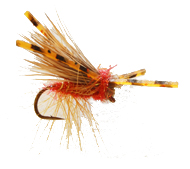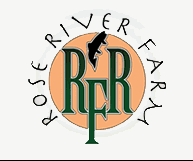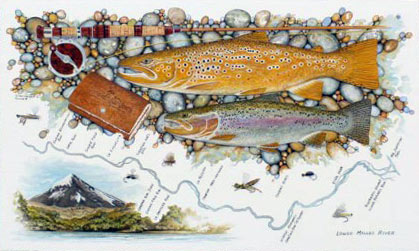Hair & Fur!
Your source for flyfishing and flycraft resources since 1975.
Most of us who've been tying flies for years have a good handle on the difference between hair and fur, but for a new tyer, what is hair and what is fur can be confusing. So let me just make a quick definition of each.
'Hairs' are the long thin strands that that grow outward from the body of a mammal. It basically looks like the photo on the left of the table above. 'Fur,' on the other hand, is more like 'fuzz' that is usually much finer and 'closer' to the body.
If you have a dog or cat, the hair is obvious as you can see it each time you look at your pet. When examing the animal more closely, you'll notice the fuzz that's closer to the body, underneath the hair in most cases. This becomes even clearer when you brush your pet. A discerning look at the brush will make the difference clear to you.
Hair
There are basically two types of hair that we need to consider for fly tying: some are solid and some are not. We'll use solid hair like most other materials, just tying on what we need to make the fly we want. You attach it and it pretty much stays in place and keeps its properties. In other words, it stay put.
But 'not solid' hair has several different purposes and characteristics. Because it has air in it, it tends to float and can be good for many dry fly patterns like Elk Wing Caddis or various floating bass poppers, to name just a couple.
You might notice that I don't say it's "hollow." Some hair might be, but most is more like a foam inside where there are tiny bubbles of air throughout. It is this property that makes it flare when you apply pressure, i.e. - tie it down.
 For example, consider the fly on the left. The wing is tied with elk hair that flares upward when tied with a bit of pressure to the hook. This technique is used for many different dry flies where this type of wing is acceptable. Also, these properties are useful for 'spinning' hair for poppers, muddlers and other flies.
For example, consider the fly on the left. The wing is tied with elk hair that flares upward when tied with a bit of pressure to the hook. This technique is used for many different dry flies where this type of wing is acceptable. Also, these properties are useful for 'spinning' hair for poppers, muddlers and other flies.
So to move our discussion along, we'll start with the with the solid hairs.
Many tails, like 'bucktails' and 'calf tails,' are solid hairs that are most often used on streamers. Same with wool, calf body hair, moose body hair, black bear and so on. The buck and calf tails come in a variety of colors and are a staple for most fly tyers. Saltwater tyers, in particular, use lots and lots of bucktails. But freshwater tyers will also find them indispensible for streamers such as Mickey Finns, Black-Nosed Dace, Gray Ghost and so on.
Moose mane and body hair have long, thick solid fibers suitable for tails and some bodies. Wool, 'Icelandic' and 'Ram' are used for streamers in a fashion that is similar to the use of buck tails. You'll find that over time, your preferences will mature as you favor one hair over the other. This is natural and takes time.
This would be a good place to mention 'Synthetic Yak Hair.' For many tyers, this man-made material is a top choice as a replacement or adjunct to the above mentioned solid hairs. It has a translucency, sheen and comes in an endless array of colors. It swims like bucktail and has fibers that are nearly 20" long. Give it a try on your baitfish imitations, especially if you tie for saltwater.
Deer and elk hair, on the other hand, are used for their flaring properties. And although many of you are familiar with fly patterns such as the Elk Hair Caddis, there are many other uses. In fact, the 'types' of deer hair and elk hair, some of which are listed below can be quite intimidating to learn. But to cut down the confusion, start with a good piece of 'cow elk' for your tying table. A good fly tyer can accomplish much with only this type of flaring hair.
For those who are more adventurous and accomplished, consider the following varieties of deer hair: 'comparadun,' 'spinning,' 'belly,' 'humpy,' 'stimulator,' 'coastal' and my personal favorite, 'all purpose' deer hair. When I say 'all purpose,' I mean it. Just start there and begin your adventure.
Elk hair has similar variations: 'cow,' 'bull,' 'yearling,' 'early season' and so on. As I said earlier, just get a good piece of cow elk and go from there. Do not confuse the issue any further.
Fur
As we said earlier, 'fur' is the softer, non-spikey material found closer to the body of an animal. We use it primarily for dubbing onto the thread, in order to make the body of a fly. You can find fur dubbing material on many, many animals and pieces are available for just that. Among the most popular are hare (rabbit), squirrel, bear, muskrat, beaver, fox and so on. Don't be shy about trying them. Most come in a wide variety of colors and you'll enjoy tying nymphs and some dries with these.
I mentioned hare above, but it needs a quick discussion of its own. Rabbit or hare fur is one of the most popular nymph dubbing materials. Because it absorbs water quickly, you'll find it used on many nymph and wet patterns. You'll usually find hair mixed in with it, called 'guard' hairs, that are spikey and help nymphs have a natural 'buggy' look. In particular, the hare's mask is valuable for this type of dubbing. All fly tyers will want to have a mask in a couple of colors handy on their tying table.
Lastly, strips of rabbit, often called 'Zonker' strips, can be used for a variety of flies including 'Matukas,' 'Leeches' and 'Zonkers.' These are available in two 'cuts.' Horizontal, which is from the head to the hind feet, are considered regular for bodies, backs and tails. 'Crosscut,' which is horizontally cut, are used for collars and a few other purposes.
In conclusion, don't be intimidated by the number of different choices. Instead, think about the flies you use most often or want to learn to tie. Find a knowledgeable shop, ours for instance, and purchase the hair and fur you need for those patterns. As you tie more and more, your grasp of the differences will grow, along with your repertoire of fly tying techniques.
Shop Hair, Fur & Materials @ Hook & Hackle






